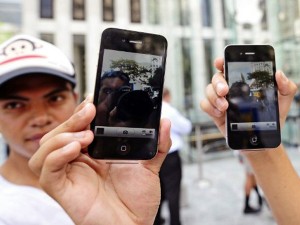SAN FRANCISCO—An outbreak of iPhone fever made Apple the hottest smartphone maker worldwide at the end of 2011 but handsets powered by Google’s Android software were shaping up as true winners in the market.

Apple fans display iPhone4s after waiting in line to become the first owners of the latest-generation iPhone, called the iPhone4, as it made its global debut in five countries in 2010 in New York. AFP
Worldwide shipments of smartphones soared 54.7 percent in the final three months of 2011 from the same period a year earlier, with California-based Apple making the most popular models, according to an IDC report released Monday.
Smartphone makers shipped 157.8 million units in the fourth quarter of 2011, compared to 102 million in the same period the prior year, IDC reported.
A total of 491.4 million smartphones were shipped during the year, up a “strong 61.3 percent” from the 304.7 million units in 2010, according to IDC.
Apple had a 23.5 percent share of the global smartphone market, followed by Samsung and Nokia with 22.8 percent and 12.4 percent respectively.
“So-called ‘hero’ devices, such as Samsung’s Galaxy Nexus and Apple’s iPhone 4S, garner the bulk of the attention heaped on the device type,” said Kevin Restivo, senior research analyst with IDC’s Worldwide Mobile Phone Tracker.
“But a growing number of sub-$250 device offerings, based on the Android operating system, have allowed Google’s hardware partners to grow smartphone volumes and expand the market concurrently.”
While Apple tightly controls iPhone hardware and software, Google makes the Android mobile device operating system available free to smartphone manufacturers who have been building it into ranks of handsets.
Android and iPhone smartphones accounted for slightly more than 90 percent of US smartphone sales in the fourth quarter of 2011, industry-tracker NPD Group reported on Monday.
Android commanded 48 percent of the market compared to Apple’s 43 percent, according to NPD.
NPD figures indicated that Android handsets were more popular with first-time smartphone buyers in the United States, with its share of that market at 57 percent compared to Apple’s 34 percent in the fourth quarter of last year.
“Android has been criticized for offering a more complex user experience than its competitors, but the company’s wide carrier support and large app selection is appealing to new smartphone customers,” said NPD analyst Ross Rubin.
Apple jumped into the third spot in the overall global mobile phone market from fifth place in the final quarter of the year due to a record-breaking quarter for iPhones, according to IDC.
Apple sold 37.04 million iPhones in the quarter which ended on December 31, giving it a market share of 8.7 percent.
Nokia remained king, shipping 113.5 million mobile phones in the final quarter of the year to claim nearly 27 percent of the market.
Samsung was second with 22.8 percent of the market, or 97.6 million handsets shipped.
South Korea’s Samsung, a star producer of Android smartphones, hit a new milestone in the final quarter of the year, more than tripling handset shipments to top the 35 million mark for the first time.
Nokia and Canadian BlackBerry maker Research In Motion saw shipments drop by 30.6 percent and 11 percent, respectively.
Nokia hopes to reverse the losing trend with a new line of smartphones based on mobile gadget software crafted by US technology colossus Microsoft.
A total of 427.4 million mobile phones were shipped in the final months of 2011 in a 6.1 percent increase from the same quarter a year earlier, IDC said.
IDC warned that the growth rate in the fourth quarter of 2011 was weaker than the 9.3 percent seen in the prior three-month period of the year.
“The introduction of high-growth products such as the iPhone 4S, which shipped in the fourth quarter, bolstered smartphone growth,” Restivo said.
“Yet overall market growth fell to its lowest point since the third quarter of 2009 when the global economic recession was in full bloom.”